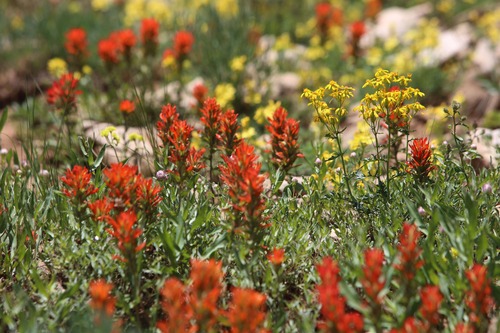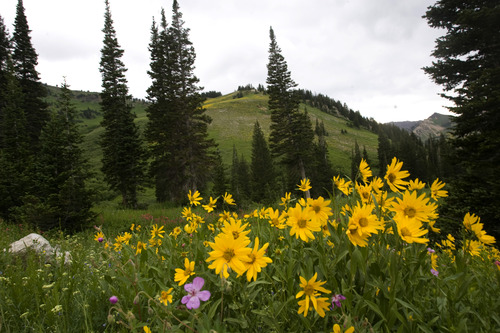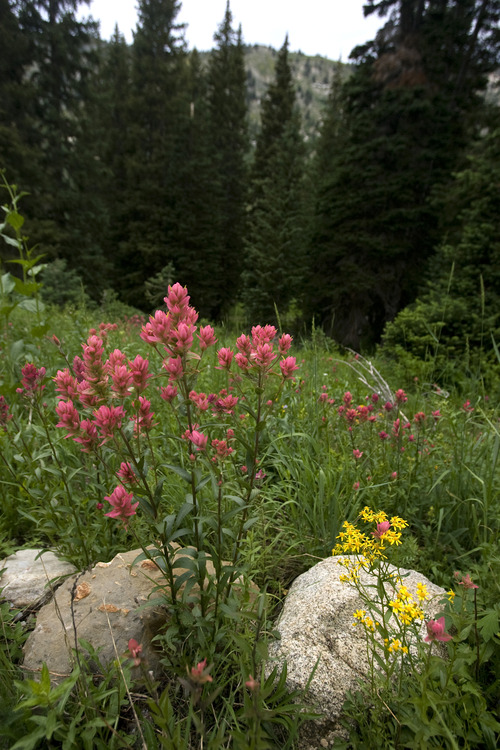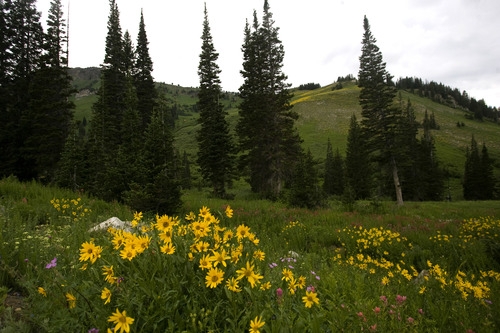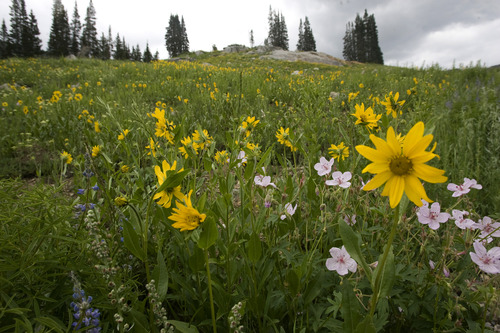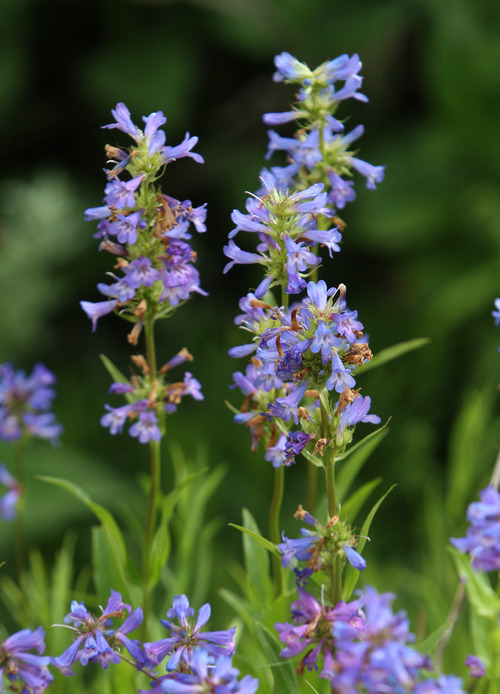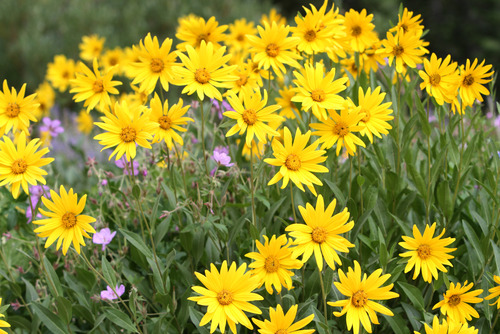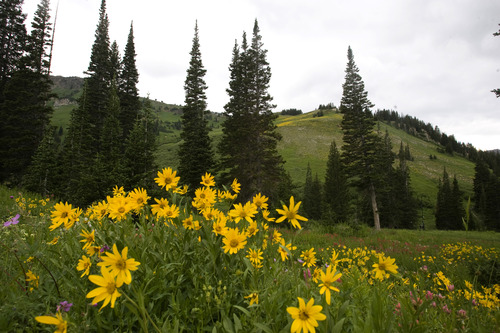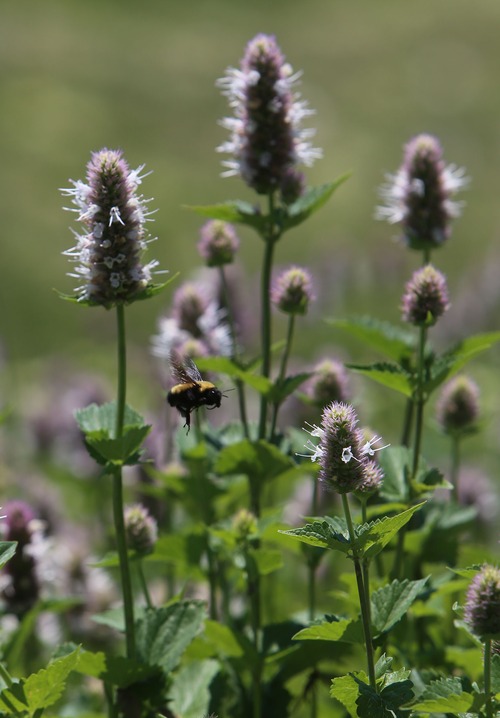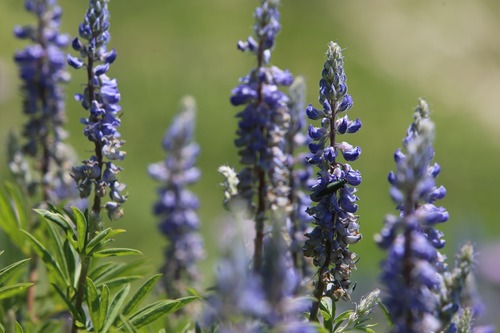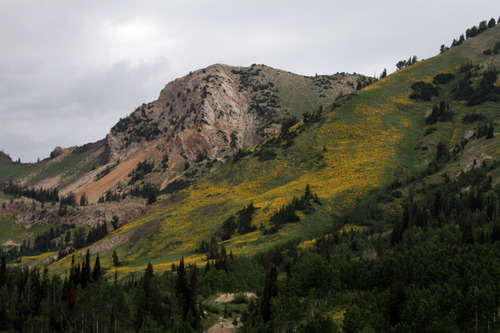This is an archived article that was published on sltrib.com in 2013, and information in the article may be outdated. It is provided only for personal research purposes and may not be reprinted.
Alta • Bright jackets, boots and skis are not the only blasts of color in Albion Basin at the top of Little Cottonwood Canyon.
The more natural hues of red and gold take a turn in the seasonal display each autumn. But the real outburst happens each summer when the wildflowers of Utah's high country bloom en masse.
"It is absolutely astounding and vastly underappreciated," said Richard Middleton, who at 75 volunteers to lead walks during the annual Wasatch Wildflower Festival. "We did a training course at Silver Lake [at the top of Big Cottonwood Canyon] once and counted 75 different flowers in bloom. How many places can you find that in 3/4 of a mile?"
According to the Cottonwood Canyons Foundation, which hosts the annual Wasatch Wildflower Festival along with the four ski resorts and local, county and federal partners, there are 1,200 different species to be counted along the Wasatch Range. Many blossom during a short time span each summer, carpeting meadows, luring outdoor enthusiasts to the mountains.
"Summer at these high elevations is so intense because it is such a short growing season, so when it really peaks it is just spectacular," said Jessie Walthers, Cottonwood Canyons Foundation director. "Nature is so abundant and doing everything it can to bloom and send everything to seed in that time frame. It is a time of vibrant intensity."
The festival is being held July 26-28 with nature walks, music and kids' activities and stops at each of the four ski resorts: Brighton, Solitude, Alta and Snowbird.
The Cottonwood canyons, of course, are not the only places to find natural wildflower tapestries. Cedar Breaks National Monument east of Cedar City also holds an annual wildflower festival. Other popular locations that only require a drive to witness the flowers include Wolf Creek Pass (State Highway 35 between Woodland and Tabiona); Monte Cristo (State Highway 39 between Huntsville and Woodruff); Boulder Mountain (State Highway 12 between Boulder and Torrey); Logan Canyon (Highway 89 between Logan and Bear Lake); and Guardsman Pass (between Brighton and Park City), to name a few.
Some people are fine just seeing the plethora of wildflowers, but others are curious and question what they are seeing.
The guided walks are an excellent place to start a more intimate knowledge of the fauna of the canyons. It is, after all, how Middleton and fellow nature-stroll volunteer Bob Benton got their start in wildflower identification.
"The first flower that made me want to know its name was the Wasatch penstemon," Benton said. "That thing is wired with electricity. I had never seen anything that bright. Once you see one you want to see another one."
Benton taught himself the flowers of the canyons and now enjoys helping others learn the names. He tells people on his walks, which range from wide-eyed toddlers in backpacks to hikers enjoying their seventh or eighth decade in the mountains, not to worry if they can't remember all the flowers he points out.
"It is the peak of the season, and there are so many to remember. It can be frustrating. I tell them if they can remember just two they are doing well," he said. "I encourage them to take another hike and maybe they will be able to add another one or two and pretty soon they can lead the walks."
Learning the names, Walthers says, is creating an important connection to the plant, the mountain and the canyon.
"Knowing the names of the plants is a more intimate and sensitive way to enjoy our mountains," she said.
The volunteer guides also discuss the importance of watching where you step in the woods. They describe the environmental impact of plucking flowers to share at home.
"If you pick flowers you are not only taking food away from pollinators and other wildlife. You are also taking away the next generation of wildflowers and stealing the opportunity for others to enjoy them as well," Middleton said. "If we have 100,000 visitors in the canyons every year and everybody picks just one flower, that is a real impact."
Walthers said the festival is about more than the wildflowers; it is also about the place where they grow.
"The wildflowers are such a treasure in the summer in the Wasatch, and they're also a sign of a healthy watershed," she said. "It's in all our interests to be sure they are protected and well cared for; for their beauty, but also our own drinking water."
For Benton, the flowers are just another excuse to escape from hot weather and life in the big city.
"You walk a bit from the trail head and stop. You look around and think, 'This must be where the gods live,' " he said. "It is so incredibly lush, so incredibly vibrant and it is 20 minutes from our homes. It is just so special."
brettp@sltrib.comTwitter: @BrettPrettyman @UtahBucketList —
Ready to go wild for wildflowers?
The Wasatch Wildflower Festival is being held at the four ski resorts in Big and Little Cottonwood canyons Friday through Sunday, July 28.
• Check the festival website for a schedule and details on wildflower tours. > wasatchwildflowerfestival.org
• The Cottonwood Canyons Foundation will have its book, Wildflower Guide to Big and Little Cottonwood Canyons, available at all festival events for a $15 donation. The book includes about 75 species of flowers commonly spotted in the canyons.
• See a video of the wildflower festival. > bit.ly/bucketflowers —
The Utah Bucket List
View a video trailer of "The Utah Bucket List," which premieres Aug. 1 on KUED-Channel 7, at http://bit.ly/19tPLWx.
See a video of a the wildflower festival at http://www.youtube.com/watch?v=lGlSbv-Rzx4
Check out the list's Facebook page at http://www.facebook.com/UtahBucketList and tell us what you think should be on The Utah Bucket List.




